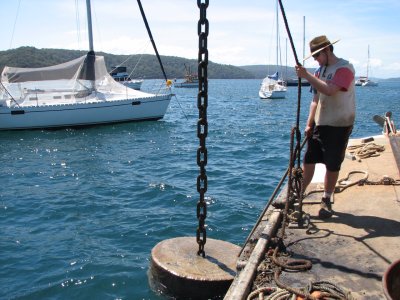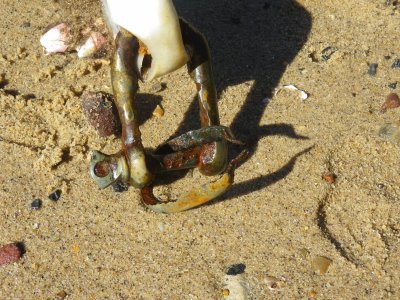ylop
Well-known member
This might be a really dumb question!
I’ve picked up moorings with 1.5-2” rope pennants (usually with chaff protection) before. I’ve also picked up moorings with no pennant where you feed your lines through the eye on the bouy. But Ive discovered a new arrangement - a chain pennant - and am wondering if there is a well recognised approach for these.
For now, I’ve moved the anchor off the roller, brought the pennant chain (which is much larger than my anchor chain) over the roller and then “tied” it off using basically an OXO on a bow cleat. I’ve then tied a rope to the chain just aft of the anchor roller and cleated in on the other bow cleat so that the rope is carrying the load and the chain OXO is a backup.
I’m sure it’s secure, but it was quite a bit of faff, the anchor is too heavy for my crew to lift without risking injury.
I am about to take on a mooring laid by the same contractor in the same area so expect it will have a similar arrangement. I’d like it to be simple and safe enough for my crew to comfortably handle on the foredeck for either arrival or departure.
1. Is there a standard approach?
What I am thinking might be best would be to make up a very beefy bridle coming into the boat over the fairleads (which are about 6” back from the bow) on each side and then onto the cleats which are about 2’ aft of the fair leads. The bridle could then have a nice spliced metal eye at its midpoint (stainless of galv?) and be attached to the galvanised chain (2. how best to do this so it’s easily attached/removed/doesn’t seize if left for 3 weeks?). The slack chain and pick up bouy would come over the bow but preferably not need to come through the anchor roller. 3. Is there a neat way to keep that from banging around? Perhaps a soft shackle to the bow roller?
The chain itself then still needs secured somewhere. In case either or both parts of the bridle fail or the “hook” to the chain comes off…. If there’s a beefy bridle on the cleat I can’t see I could realistically get the chain in any OXO style onto the cleat too. 4. Could it be shackled to the cleat?
5. If making a bridle would you put soft eyes that can just be dropped over the cleats and are the perfect length or is there a benefit to being able adjust the length and tying them off? I think just dropped over makes sense but I’ve always been paranoid they might mysteriously jump off and added a line in an oxo over the top. Is that just paranoid?
Final question - looking around the moorings other people seem to have very different lengths of chain penance still between them and bouy. Some are perhaps bringing just a foot of chain in and securing it - leaving 3-4m ? to the bouy, others have brought in much more leaving only 1m or so. 6. Are there pros/cons of each?
Before anyone says “whatever your insurer says” they don’t stipulate - but presumably if I do something unconventional they will have a view! Surprisingly whilst my various text books have sections on how to pick up a mooring, none seem to cover what you do with the pennants at all! So it’s either obvious and I’m being dumb / paranoid OR (and Google would suggest this may be the case) custom and practice is local geography specific? It West of Scotland - March-October. 32’ Boat.
I’ve picked up moorings with 1.5-2” rope pennants (usually with chaff protection) before. I’ve also picked up moorings with no pennant where you feed your lines through the eye on the bouy. But Ive discovered a new arrangement - a chain pennant - and am wondering if there is a well recognised approach for these.
For now, I’ve moved the anchor off the roller, brought the pennant chain (which is much larger than my anchor chain) over the roller and then “tied” it off using basically an OXO on a bow cleat. I’ve then tied a rope to the chain just aft of the anchor roller and cleated in on the other bow cleat so that the rope is carrying the load and the chain OXO is a backup.
I’m sure it’s secure, but it was quite a bit of faff, the anchor is too heavy for my crew to lift without risking injury.
I am about to take on a mooring laid by the same contractor in the same area so expect it will have a similar arrangement. I’d like it to be simple and safe enough for my crew to comfortably handle on the foredeck for either arrival or departure.
1. Is there a standard approach?
What I am thinking might be best would be to make up a very beefy bridle coming into the boat over the fairleads (which are about 6” back from the bow) on each side and then onto the cleats which are about 2’ aft of the fair leads. The bridle could then have a nice spliced metal eye at its midpoint (stainless of galv?) and be attached to the galvanised chain (2. how best to do this so it’s easily attached/removed/doesn’t seize if left for 3 weeks?). The slack chain and pick up bouy would come over the bow but preferably not need to come through the anchor roller. 3. Is there a neat way to keep that from banging around? Perhaps a soft shackle to the bow roller?
The chain itself then still needs secured somewhere. In case either or both parts of the bridle fail or the “hook” to the chain comes off…. If there’s a beefy bridle on the cleat I can’t see I could realistically get the chain in any OXO style onto the cleat too. 4. Could it be shackled to the cleat?
5. If making a bridle would you put soft eyes that can just be dropped over the cleats and are the perfect length or is there a benefit to being able adjust the length and tying them off? I think just dropped over makes sense but I’ve always been paranoid they might mysteriously jump off and added a line in an oxo over the top. Is that just paranoid?
Final question - looking around the moorings other people seem to have very different lengths of chain penance still between them and bouy. Some are perhaps bringing just a foot of chain in and securing it - leaving 3-4m ? to the bouy, others have brought in much more leaving only 1m or so. 6. Are there pros/cons of each?
Before anyone says “whatever your insurer says” they don’t stipulate - but presumably if I do something unconventional they will have a view! Surprisingly whilst my various text books have sections on how to pick up a mooring, none seem to cover what you do with the pennants at all! So it’s either obvious and I’m being dumb / paranoid OR (and Google would suggest this may be the case) custom and practice is local geography specific? It West of Scotland - March-October. 32’ Boat.


